Pencil Drawing from Nature |
|||||||||||||||||||||
|
Page 05 / 14
CHAPTER IV BEFORE touching a brush, one should make a series of pencil drawings of the subject one afterwards intends to paint. The landscape painter may, after spending many days on a picture, despairingly conclude that the composition is hopeless. The disappointment might have been avoided had he curbed his impatience, and executed a series of preparatory drawings for the composition in his sketchbook. For this purpose I would recommend a large linen-covered book (15 inches by 12 inches is a good size) and a thick lead pencil. I use a pencil with a loose lead, one-eighth of an inch thick, which can be screwed up in the holder when required. Do not attempt to sharpen it to a point. If you wish to get a thin line, use the edge of the lead , but you will seldom need such a line. Touch lightly, and in the faintest possible manner, the salient features of the subject, the main contours and the position of the masses. This should be the merest suggestion of an outline, and when you are satisfied, draw it in with courage, in big lines, with a firm, bold touch. Do not hesitate. Include only those things which are important, characteristic and essential. After some experience you will not stop to think what these things are, for they will come to you by intuition. If you have any doubts, draw all that comes within your view. By practice you will be able to make a drawing in a few minutes which spontaneously indicates the principal parts of your proposed picture. You can carry it a step beyond the mere outline, if you like, and add the shading of the broader masses, for you may discover that in pencil-work, as in painting, light and shade influence the quality of form. A week or two will do wonders if you practise daily. Have your sketchbook with you at all times -- not only when you have a specific object in view, such as that already referred to, but ready for any opportunity that occurs. It should be your constant companion. It is more useful than your colour-box, in the sense that it is more convenient. You can take a note of an interesting cloud formation, the peculiar shape of trees, or some bit of useful foreground, or of the movement of a figure. Draw anything, everything. You may do it badly at first. Never mind. In a week or two you will be surprised at the progress you have made. You will by that time have learned more than you ever knew by previous theorising, and you will begin to look for better qualities of drawing than you did before. You will construct things better ; you will also observe the difference in the growth of the various species of trees, and if you are drawing a cow, you will see that the shoulder is just so far from the head, you will note the correct set of the horns, the peculiar formation of the jaw, everything in fact will have a new interest for you. 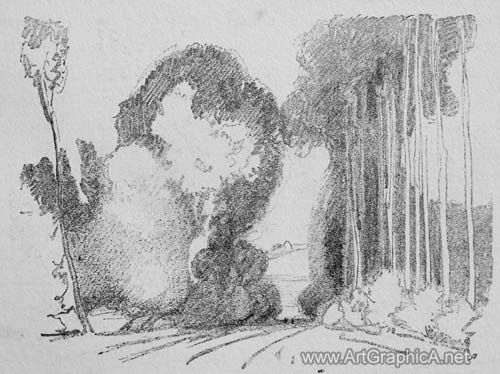 First sketch for "The Avenue". Pencil Drawing from Nature Your sketchbook should be the receptacle for designs of landscapes, and when by means of these drawings you have accumulated the best material and have obtained a satisfactory result, you can then begin your picture with confidence. 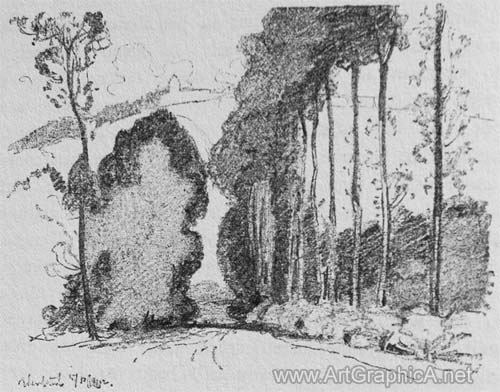 Second Sketch for "The Avenue". 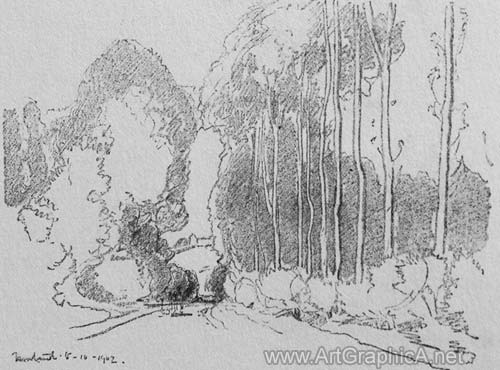 Third Sketch for "The Avenue". Pencil drawing from nature. 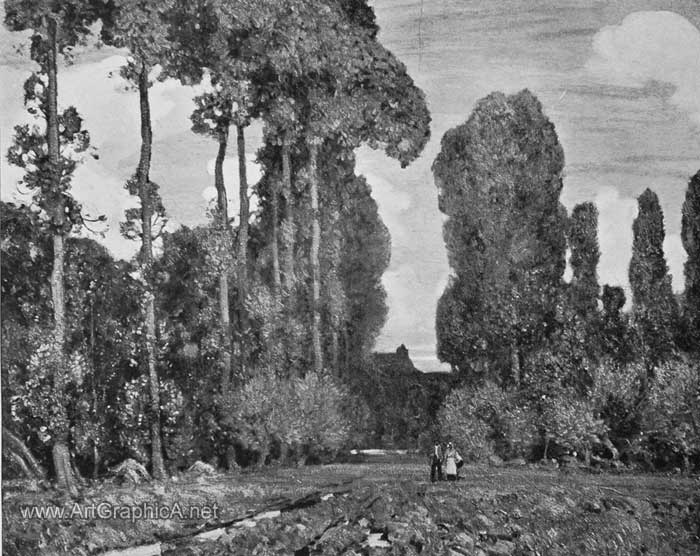 The Avenue. You will see in the accompanying illustrations from my sketchbook three trials for a composition, each of the same spot, but all different. In the first sketch I have placed the trees as they were in Nature, in the second I have made an alteration in the distance, and the third is the final composition which I afterwards painted but reversed. I recommend you frequently to practise the drawing of trees. Take, for example, the ash, which is not so difficult as many others ; then proceed to the oak, willow, elm and poplar. Draw in the landscape, so as to get an idea of the composition, and when you are competent, re-arrange the material before you to suit the purpose you have in view. Never let anything prevent your drawing a little every day. Draw the intricate hedgerow, or the big cloudy sky. It is necessary discipline, and what scales and exercises are to the pianist, so is pencil drawing to the artist. One's hand grows sensitively obedient to the brain, and answers directly to one's power of observation, like the touch of a musician's hand upon the keyboard. He does not stop to calculate the interval which will produce harmony, but obtains it by an instinct which is the result of long practice, and so the artist's hand as naturally expresses what he sees. The delight in the easy and competent expression of form is only surpassed by the delight in the expression of colour, and those two qualities of sensitiveness to form and colour go to the making of a painter. At first you will probably find sketching with the pencil irksome, but the taste for it will grow. In spite of your inclination towards colour, you will learn to love it. So certain will your touch become by persistent practice, that you will feel the drawing. You will get that something in the work which lifts it above the merely mechanical imitation, to that higher plane which is instinct with life. In such study you will notice many things that had previously escaped your observation, and instead of making a laboured mess of your pencil drawing, your hand will answer to your eye directly and confidently. 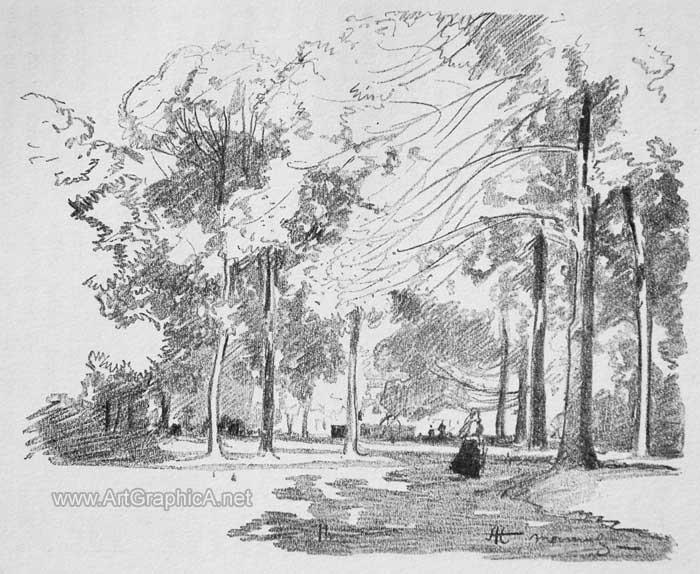
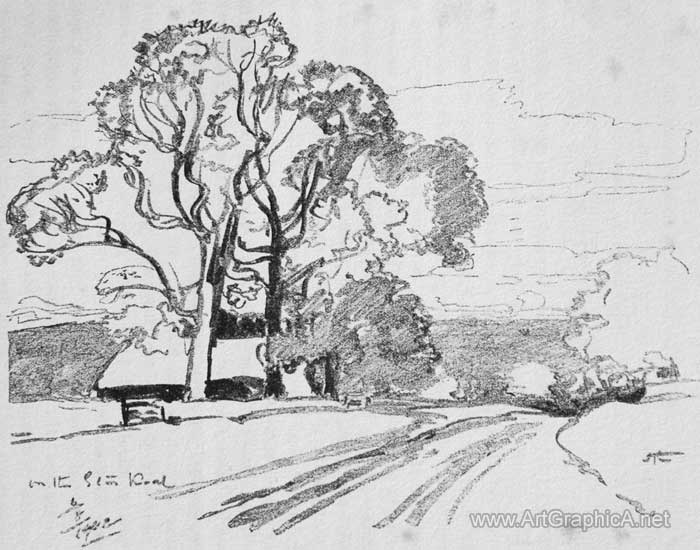
Pencil drawing, as I have attempted to show, is not only useful to you in your trials for a composition, in which you have faced the problem of transposition of the forms of Nature, but as a means of obtaining studies of materials which will enable you to suggest in the broad masses of your painting, the multitude of details which build up its breadth, and in such a way that although not literally drawn, they are so suggestive that they give one the satisfaction that they are complete.
Next Page
Prev PageArt Composition Sketching from Nature
|
|||||||||||||||||||||








